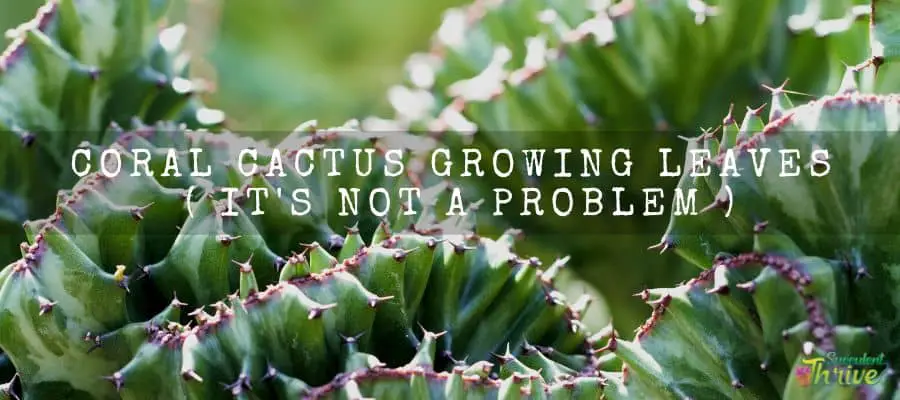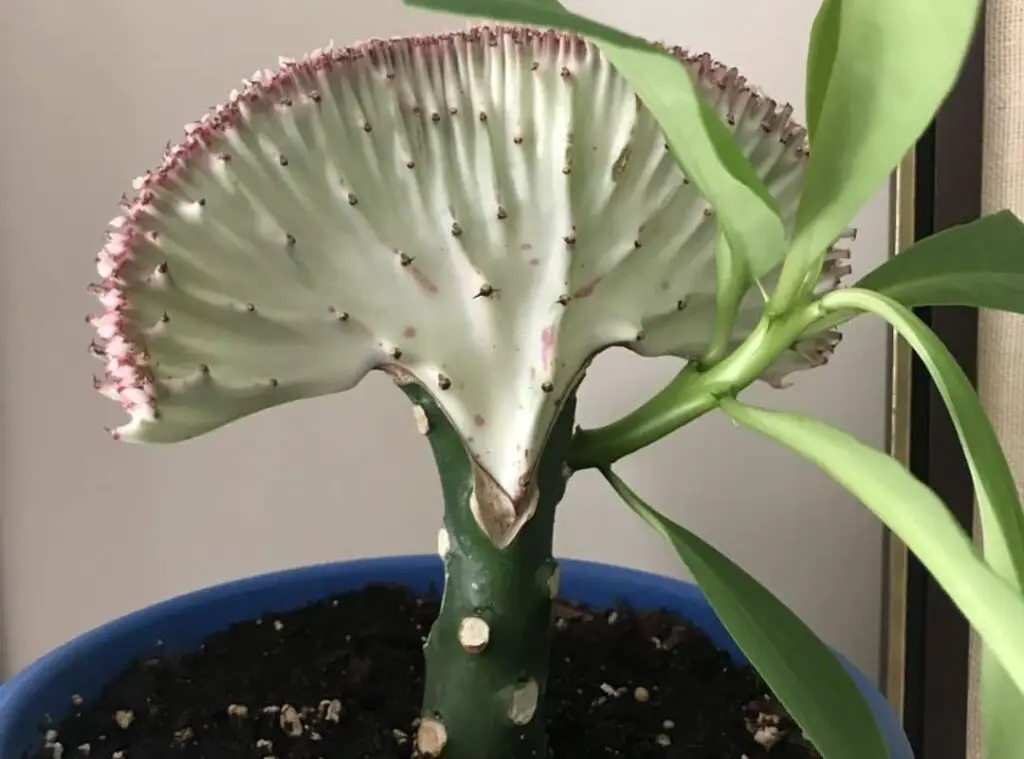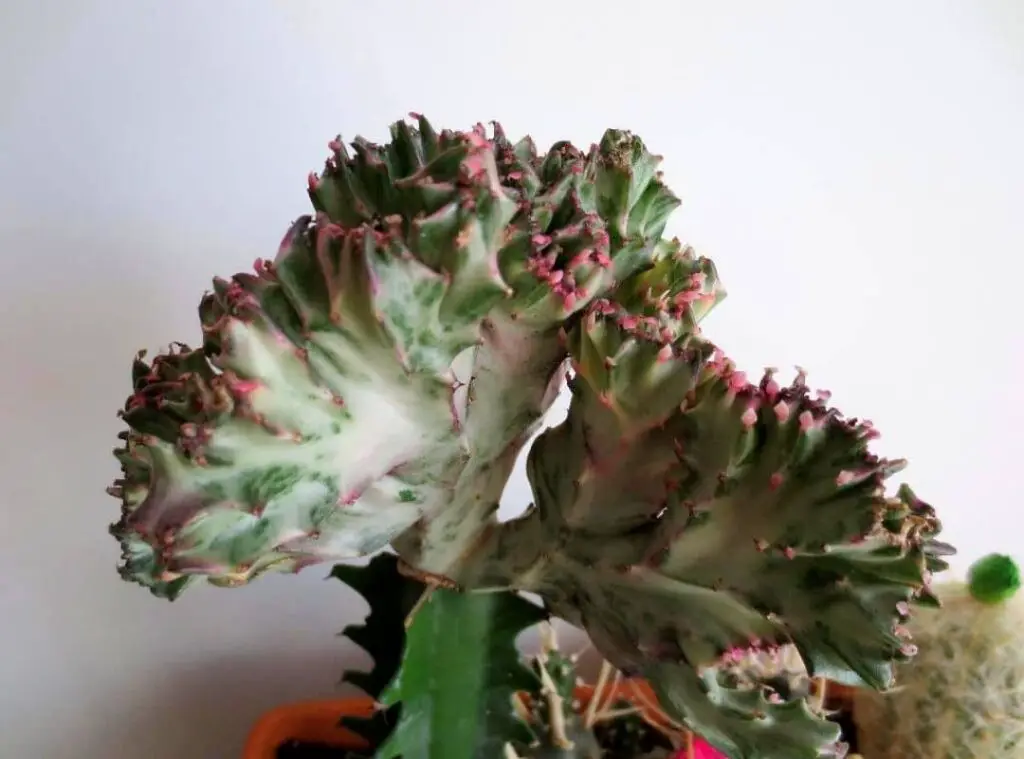Coral cactus growing leaves might be the biggest problem of coral cactus growers. So I am going to give you a solution.

Why are my coral cactus growing leaves?
Your coral cactus may start to grow leaves as it is a sign to let you know the bottom part is growing well and that it could support the grafted plant.
You all know that coral cactus is a graft between two plants. In addition to that it could also be due to the rootstock formation too. It is up to you to decide whether you need to let them grow that way or you may even snip them off too.
I suggest you leave them that way as they could produce extra food. However, some people might not agree as they may consider this as an untidy formation of coral cactus.
What is coral cactus?
Coral cactus is a graft of two plants, and they have a close resemblance to ocean corals. That’s why they got the name coral cactus.
Coral cactus is not a cactus but a combination of two succulents which will form in a franken plant. Coral cactus’ genus is Euphorbia and they have more than 200 succulent species in total.
However, keep in mind that they release a poisonous sap which could be poisonous once they are cut. As such ensure that you are protecting yourself before dealing with the plants.
Euphorbia neriifolia is what many people use as the base plant, and they will consist of wider leaves which tend to take an oval shape.
However, you could use the rest of other Euphorbia plant varieties also as the root stock. On the other hand, it would be a crest from another plant which is used as the top part of the coral cactus.
Many people use Euphorbia lactea as the top part of the coral cactus, and they would consist of ripped leaves which tend to look like a fan.
When the whole thing comes together, it would resemble the look of an unusual coral. You need to graft them in a way where you make a v shape cut at the crest bottom whilst using a sharp sterile knife.
Simultaneously you need to make a concave v shaped cut in the root stock top as well. Next you need to bid them with twine and consider covering them with the grafting wax so that it will avoid the exposed tissues withering.
Only matured plants can produce flowers. However, keep in mind that coral cactus could result in irritations in skin as well as in your eyes. Hence it is crucial that you wear all the protective gear to safeguard yourself.

Why do cactuses grow arms?
Less exposure for sunlight for prolonged periods could result in growing arms in your cactus. They would try to form arms to reach a lighting source they can approach.
You could commonly spot this among the indoor grown cactus. When you grow cactus outdoors, they will receive more sunlight when compared to indoor grown coral cactus. The exposure for adequate sunlight is crucial to have a firm growth in your cactus.
Why is my succulent growing an arm?
If we take indoor grown succulents into consideration, they will develop arms in order to reach a sunlight source just like the cactus.
You could spot this condition among both indoor grown succulents and in outdoor grown succulents which are growing in shade for too long as well. You can use the arms for propagation.
What to do when your cactus grows leaves?
You can either use them for the propagation process and let them grow that way for some time and you do not need to prune them.
As aforesaid your coral cactus may grow leaves due to rootstock formation also. In that circumstance, you can cut the leaves and the sprouts on the root stock.
Protect yourself from the toxic sap when you make the cuttings. In case if the sap gets in contact with your skin, it could create irritations in your skin as well as in your eyes.
In fact, it could even make you blind too. Moreover you may use them for the propagation process and make new plants too.
Can we avoid coral cactus leaves?
Ensure that you look after the plants so that your coral cactus will not go through such conditions. If you damage any sprout of the plant, there will be a great probability for the remaining sprout to form larger leaves.

Related questions
How much sun does a coral cactus need?
If the plant is being grown inside, pick a location with at least 3 to 5 hours of direct sunshine every day, such as a south-facing window. Additionally, it’s crucial to routinely turn your coral cactus.
Is coral cactus poisonous to dogs?
All parts of Coral cactus are deadly and should not be consumed by either people or animals. Additionally, it produces a sap that needs to be removed right once to avoid causing skin irritation. It’s a good idea to wash your hands or put on gloves after handling.
How big will a coral cactus get?
Coral cactus only reach heights of 9 to 15 inches, therefore they are not particularly large. The good news is that coral cacti won’t outgrow their pots, so you won’t need to repot them very often.
Can you propagate coral cactus?
From stem cuttings, “Coral Cactus” can be propagated. Just cut a piece off the stem with a sharp, clean knife or pair of scissors. After letting it dry for a day or two, plant the cutting in a soil that drains properly. When the soil is entirely dry, water it.
Final thoughts
Coral cactus growing leaves is a problem for many coral cactus growers. But it is a completely natural phenomenon. Therefore you do not have to worry if your coral cactus is growing leaves.
However you want to remove unwanted leaves you can prune those leaves one a month. It is fun growing coral cactus and if you take care of the plants well, they will reward you with beautiful plants.
Read Next : What Succulents Attract Hummingbirds? (11 Plants)
